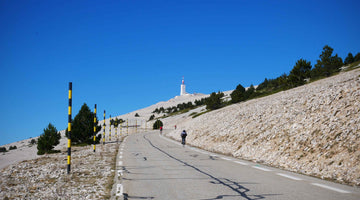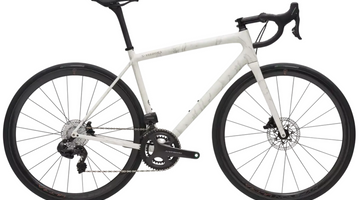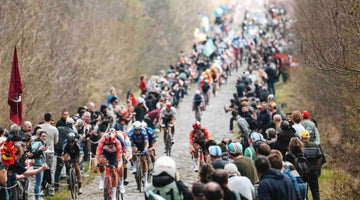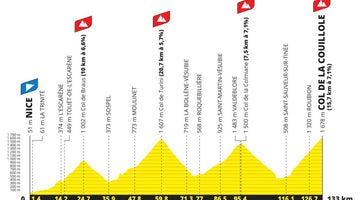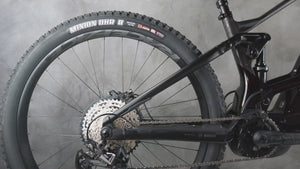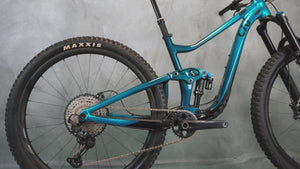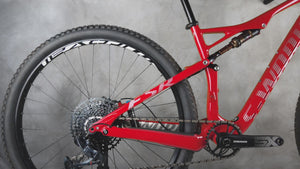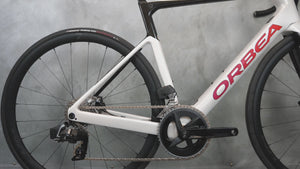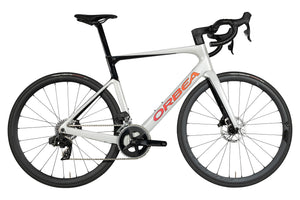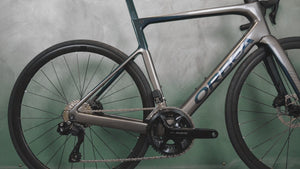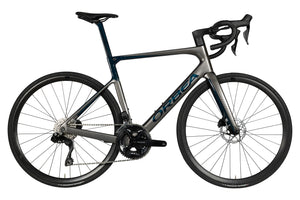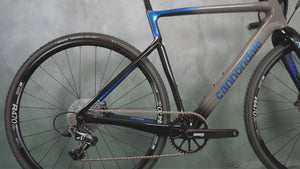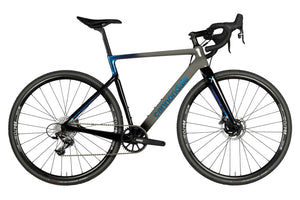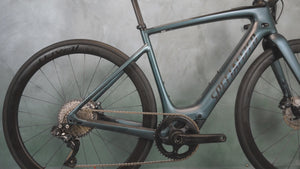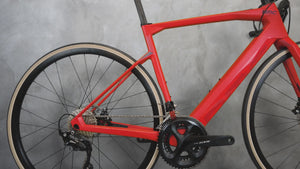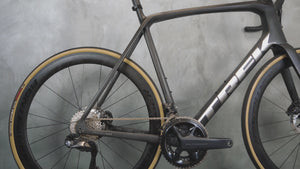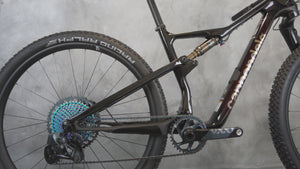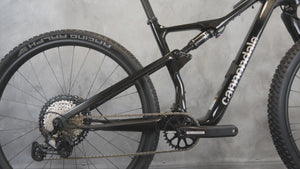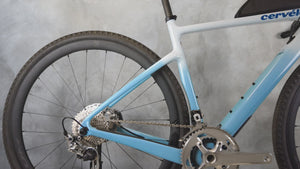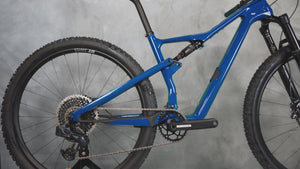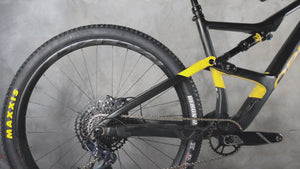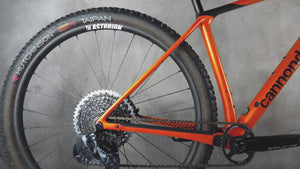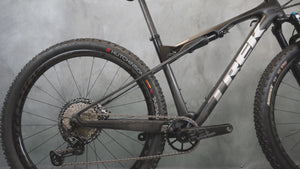Which Mountain Bike to Choose for Bikepacking
In this Article
Published on 11 September 2024
Bikepacking is the art of travelling light on a bike. Here, there's no luggage rack or other utility items to carry your gear, just a few lightweight bags for heading out on an adventure. This form of travel is becoming increasingly popular, and with good reason—bikepacking offers true freedom. Whether you're a novice or an expert, it's essential to select a bikepacking mountain bike that suits your needs, taking into account factors such as the type of suspension, weight, and the terrain conditions you'll be riding on. In this article, we guide you through the different options available to find the best mountain bike for bikepacking, so you can enjoy uncompromised adventures off the beaten track.
The essential criteria for choosing a bikepacking mountain bike

The essential criteria for choosing a bikepacking mountain bike ©Restrap
To help you identify the essential criteria for choosing the best bikepacking mountain bike for your needs, it's crucial that you ask yourself the right questions. This will allow you to clearly define your expectations and choose a bike that perfectly matches your bikepacking adventures.
Here’s a list of questions to consider before purchasing a bikepacking mountain bike:
The different types of mountain bikes for bikepacking
To choose the right model for your needs, it's important to look at all the types of mountain bikes available on the market today:
- Rigid mountain bike
- Hardtail mountain bike
- Full-suspension mountain bike
- Electric hardtail mountain bike
- Electric full-suspension mountain bike
Each of these bikes will allow you to venture onto trails for a unique bikepacking journey. However, these bikes have their own specific features.
Rigid mountain bike: lightweight for uncompromised bikepacking

Rigid mountain bike: lightweight for uncompromised bikepacking ©nicolas_joly
Choosing a rigid mountain bike for bikepacking means opting for simplicity. With no suspension, the rigid mountain bike is particularly suited to rolling terrains and less technical trails. Its minimalist design reduces the bike's weight and minimises maintenance needs. Opting for a rigid mountain bike is choosing an efficient bike, ideal for those who want to cover long distances with minimal technical constraints.
Advantages:
- Lightweight: The lack of suspension reduces the bike's weight.
- Simplicity: Fewer components mean less maintenance.
- Efficiency: Better performance on less technical terrains.
Disadvantages:
- Lack of comfort: The absence of suspension results in direct transmission of shocks, leading to more physical fatigue.
- Reduced versatility: Less suited to technical terrains and requires good riding skills on rough sections.
Who is the rigid mountain bike for in bikepacking?
Rigid mountain bikes are aimed at experienced cyclists with good physical condition who are looking for a minimalist bike that requires little maintenance for non-technical terrains and short to medium rides.
Hardtail mountain bike: the ideal compromise for bikepacking

Hardtail mountain bike: the ideal compromise for bikepacking ©nicolas_joly
The hardtail mountain bike is often considered the best compromise for bikepacking. This type of bike is equipped with front suspension and offers increased comfort on technical terrain. The versatility of the hardtail mountain bike allows it to adapt to a wide range of terrains, making it an excellent choice for those who want to explore varied terrains without sacrificing performance or comfort.
Advantages:
- Front suspension: Better shock absorption for more comfort on rough terrain.
- Versatility: Suitable for a wide variety of terrains for different bikepacking conditions.
- Reasonable weight: Lighter than a full-suspension while still offering good comfort.
Disadvantages:
- Limited comfort on very rough terrain: The lack of rear suspension can make some rides less comfortable on very technical terrain.
- Slightly more complex maintenance: The front suspension requires regular maintenance to remain effective. (Every 100-200 hours of use)
Who is the hardtail mountain bike for in bikepacking?
Hardtail mountain bikes are for cyclists who want a good balance between comfort and efficiency, capable of venturing onto varied terrains without compromising weight.
Explore our range of hardtail mountain bikes
Full-suspension mountain bike: the best choice for bikepacking on rough terrain

Full-suspension mountain bike: the best choice for bikepacking on rough terrain ©avoidtheavoid
For bikepacking adventurers who plan to tackle technical and rough terrain, the full-suspension mountain bike is the ideal choice. With front and rear suspension, this bike offers exceptional comfort on the most demanding trails. Whether you're riding on rocky trails, roots, or steep descents, a full-suspension mountain bike absorbs shocks for more comfort and reduces fatigue. This type of bike is designed for those who seek comfort and better handling on difficult terrain.
Advantages:
- Maximum comfort: The front and rear suspension absorb shocks to the maximum.
- High obstacle-clearing capability: Ideal for rough trails, steep descents.
- Improved control: The suspension helps manage obstacles better and maintain better traction.
Disadvantages:
- Complicated bag placement: The rear suspension limits the use of bags in the frame triangle and may require the use of custom-made bags. The presence of a dropper post may require adapting the rear bag.
- Increased maintenance: More parts mean more maintenance to keep the bike in good condition.
- Higher cost: Full-suspension mountain bikes are generally more expensive than their hardtail counterparts.
Who is the full-suspension mountain bike for in bikepacking?
Full-suspension mountain bikes are for cyclists planning technical routes who want to maximise their comfort and have control on rough terrain.
See our full-suspension mountain bikes
Electric hardtail mountain bike: assistance to go further in bikepacking

Electric hardtail mountain bike: assistance to go further in bikepacking ©Salsa
The electric hardtail mountain bike is an option that is attracting more and more cyclists for bikepacking. The electric assistance allows for greater distances to be covered with less effort. Equipped with front suspension and an electric motor often integrated into the bottom bracket, the electric hardtail mountain bike offers an excellent compromise between comfort and assistance. It is particularly suited to moderately rough terrain, where electric assistance can be an asset for managing climbs.
Advantages:
- Electric assistance: Allows you to complete a ride without excessive fatigue.
- Front suspension comfort: Improves comfort on moderately rough terrain.
- Effort management: Ideal for cyclists who don't have the fitness of an athlete but still want to enjoy themselves.
Disadvantages:
- Heavy weight: The motor and battery add significant weight.
- Limited range: The distance you can cover depends on the battery's capacity, so you'll need to manage the use of assistance depending on recharge points.
- Specific maintenance: Requires significant technical skills for motor and battery maintenance.
Who is the electric hardtail mountain bike for in bikepacking?
Electric hardtail mountain bikes are for cyclists who want to enjoy the joys of bikepacking while limiting physical exertion. The electric assistance allows even beginners to have maximum fun with reduced energy expenditure.
Discover all our electric bikes now!
Electric full-suspension mountain bike: comfort and versatility for long-distance bikepacking

Electric full-suspension mountain bike: comfort and power for long-distance bikepacking ©Focus
The electric full-suspension mountain bike is the epitome of comfort when it comes to bikepacking. This bike combines all the advantages of a muscle-powered full-suspension mountain bike with the pleasure of electric assistance. With its dual suspension and electric motor, the electric full-suspension mountain bike is ideal for bikepacking adventures for cyclists who want to venture onto varied and rough terrain without compromising their comfort.
Advantages:
- Ultimate comfort: The dual suspension combined with electric assistance offers unparalleled comfort.
- Performance on technical terrain: Thanks to the electric assistance and rear suspension, grip and obstacle-clearing capability are unmatched.
- Reduced fatigue: The electric assistance allows for longer rides without sacrificing comfort.
Disadvantages:
- Very heavy weight: The combined weight of the suspension and electric system is significant. (close to 30 kilos)
- Variable range: Depending on the battery size, usage mode, and terrain difficulty, the range can be short. (30-40 kilometres)
- High cost: It's the most expensive option, both for purchase and maintenance.
Who is the electric full-suspension mountain bike for in bikepacking?
Electric full-suspension mountain bikes are for cyclists looking for a bike that can take them anywhere, from rolling to the most technical terrains. This type of bike will be ideal for those seeking both comfort and performance.
Discover all our electric full-suspension mountain bikes
Which mountain bike for bikepacking?

Which mountain bike for bikepacking? ©Restrap
Choosing the right mountain bike for bikepacking is a decision that depends on several key criteria as we have seen. Whether you opt for a full-suspension mountain bike for more comfort or a rigid model for its lightness, a mountain bike remains an ideal choice for long distances. The key is to find a bike that suits your specific needs and fits your budget. With the right information and a thoughtful choice, you're now ready to embark on an unforgettable bikepacking adventure! So before you go, don't forget to check the checklist to make sure you don't forget anything and remember to maintain your mountain bike!














